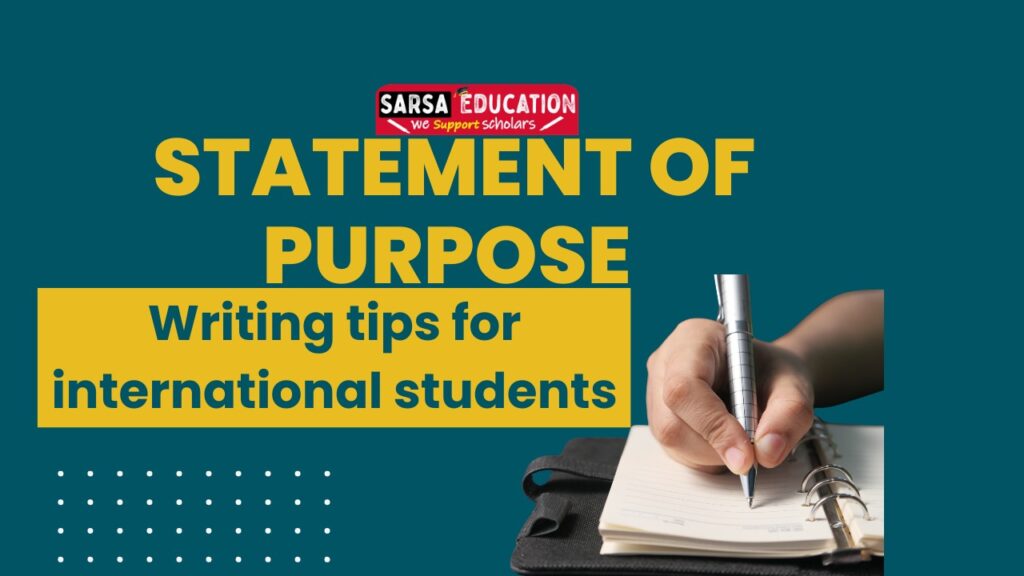A statement of purpose isn’t just a formality. It’s your personal story, your goals, and your chance to make an impression on the admissions committee. For international students, this document plays a vital role in getting admission into foreign universities. A well-written Statement of Purpose (SOP) can make your application stand out and help you secure a place in your dream college.
In this guide, you’ll learn how to write a strong, clear, and compelling statement of purpose that will increase your chances of admission. Whether you’re applying for a master’s, PhD, or undergraduate program, these tips are tailored to meet your needs.
Contents
- What is a Statement of Purpose?
- Why Is SOP Important for International Students?
- How Long Should a Statement of Purpose Be?
- Writing Tips for an Impressive Statement of Purpose
- Common Mistakes to Avoid
- Statement of Purpose Format for International Students
- Quick Writing Tips
- Final Checklist Before Submission
- Conclusion
- Important links:
- Admission Process
- Sarsa Education team support
- Frequently Asked Questions (FAQs):
What is a Statement of Purpose?
A statement of purpose (SOP) is a written essay submitted during your college or university application. It describes:
- Who you are
- What you’ve done academically and professionally
- Why you’re interested in the program
- What your future goals are
This document helps admission officers understand your motivation and how well you fit into their institution.
Why Is SOP Important for International Students?
For international students, a statement of purpose is more than just a document. It’s a chance to:
- It shows your clarity of goals
- It helps the admission committee understand your story
- It highlights your skills and achievements
- It gives you a chance to stand out from thousands of applicants
- It shows that you are serious and well-prepared
A strong SOP improves chances of getting admission and sometimes even scholarships.
How Long Should a Statement of Purpose Be?
Most universities expect a statement of purpose to be around 500 to 1000 words, depending on the course and institution. Always follow the word count mentioned in the application guidelines.
Writing Tips for an Impressive Statement of Purpose
1. Start with a Strong Introduction
Your opening paragraph should grab attention. Avoid clichés. Start with a real-life event, personal insight, or a question that reflects your passion for the subject.
Example:
“Growing up in a small village with no internet access, I developed an unusual curiosity for how technology connects the world. That curiosity grew into a career aspiration.”
2. Be Clear and Concise
Use simple language. Avoid jargon and complex vocabulary. A clear statement of purpose helps the reader understand your journey quickly and effectively.
3. Tell Your Story
Your SOP should read like a story, not a resume. Include:
- Key events from your academic life
- Relevant work experience
- What inspired your interest in the field
- Make your journey feel unique and genuine.
4.Explain Why You Chose This Program
This is a critical part of your statement of purpose. Show that you’ve done your homework.
Mention:
- Faculty names (if relevant)
- Courses or modules that excite you
- Research opportunities
- How the program aligns with your goals
5. Discuss Short-Term and Long-Term Goals
Explain how the program fits into your future.
Example:
“After completing my Master’s in Environmental Science, I plan to return to India to lead sustainability initiatives in rural areas, promoting green farming techniques.”
6. Highlight Your Achievements
Include academic awards, internships, certifications, or volunteer work. But don’t just list them—explain how they shaped your skills or passion.
7. Stay Authentic
Don’t exaggerate or lie. Admission officers can sense inauthentic statements. Be honest about challenges and failures, but show how you’ve grown from them.
8. Avoid Grammar and Spelling Errors
Use tools like Grammarly or Hemingway Editor. You can also ask a friend or mentor to proofread. Small mistakes can make a bad impression.
9. Customize Each SOP
Never send the same statement of purpose to different universities. Tailor each one to the specific program.
10. End with Confidence
Your conclusion should leave a lasting impression. Express gratitude and reinforce your interest in the program.
Common Mistakes to Avoid
- Copying content from the internet
- Using very difficult English words
- Writing unnecessary long paragraphs
- Adding fake achievements
- Not explaining future goals
- Ignoring grammar and spelling mistakes
- Writing without a clear structure
Statement of Purpose Format for International Students
Here’s a simple structure to follow:
- Introduction – Who you are and your motivation
- Academic Background – Key achievements and experiences
- Professional Experience – If applicable
- Why This Program – Show your research
- Career Goals – Short and long term
- Why This University – Specific reasons
- Conclusion – Final thoughts and gratitude
Quick Writing Tips
- Keep it 800–1000 words
- Avoid fancy vocabulary
- Stay original—never copy
- Be confident and positive
- Maintain a polite tone
- Make it personal and meaningful
Final Checklist Before Submission
Check word count
Proofread thoroughly
Avoid plagiarism
Personalize content
Keep tone professional
Make sure the keyword (statement of purpose) appears naturally
Conclusion
A well-written Statement of Purpose helps international students present their story confidently. With a simple structure, clear goals, honest writing, and proper proofreading, you can create a strong SOP that impresses the admission committee. Even if you are a fresher, you can write an excellent SOP by following these easy steps.
Important links:
- Benefits of Online MBA
- MBBS Abroad with Scholarships
- Study in Germany for free for Indian Students
- Masters in UK Fully Funded
Admission Process
Navigating university admissions can feel overwhelming, but you don’t have to do it alone. At Sarsa Education, we simplify the entire journey to the Statement of Purpose turning a complex procedure into a smooth and successful experience. We are your dedicated partner from the first inquiry to your first day on campus.
Sarsa Education team support
When you contact Sarsa Education, we immediately assign you a dedicated counselor.
Our Action: We schedule a free, in-depth consultation to understand your academic history, interests, and career ambitions
How We Help: We analyze your profile against the extensive list of courses and the specific eligibility criteria to recommend the perfect program for you at the Statement of Purpose. We provide a clear, personalized roadmap of the entire process, so you know exactly what to expect.
Step 2: We Meticulously Prepare Your Application Package
This is where our expertise becomes crucial. A perfect application is our top priority.
Our Action: We provide you with a customized checklist of all the required documents for your specific program.
How We Help: Our team meticulously reviews every single document you provide—from your academic transcripts to your passport—ensuring they meet the university’s strict standards. We identify and help you rectify any issues, such as missing stamps or needed translations, long before submission. This proactive approach drastically reduces the risk of delays or rejection.
Step 3: We Handle Your Application Submission
We take the administrative burden off your shoulders.
Our Action: Our experts complete and submit the official online application form on your behalf.
How We Help: We ensure every field is filled out accurately and that all your documents are uploaded correctly. We then guide you through the secure payment of the application fee and track your application’s status directly with the university admissions office, keeping you updated every step of the way.
Step 4: We Prepare You for the Entrance Examination
For competitive programs like Medicine and Dentistry, excellence in the entrance exam is key.
Our Action: We provide you with exclusive preparation materials, including curated study guides, sample questions, and practice tests specific to Statement of Purpose entrance exams.
How We Help: We schedule your exam and ensure you receive all technical details. Our team offers strategic tips and, if needed, preparatory sessions to boost your confidence and ensure you are fully prepared to excel.
Step 5: We Guide You Through Your Offer and Scholarship Allotment
Receiving your offer letter is a momentous occasion, and we make the next steps clear and simple.
Our Action: We immediately inform you when your Conditional Offer Letter arrives and explain all its terms in detail.
How We Help: We guide you through the final steps to convert your conditional offer into an unconditional acceptance.
Step 6: Our Comprehensive Visa Application Support
We demystify the visa process, which is often the most stressful part for students.
Our Action: We provide you with a personalized visa documentation checklist and assist you in preparing every required piece of paperwork.
How We Help: Our experts review your entire visa application package—including the acceptance letter, proof of finances, and health insurance—to ensure it is complete and compliant. We help you fill out the visa forms accurately and conduct mock visa interviews to prepare you for a successful embassy appointment.
Step 7: We Prepare You for Departure
Your transition to a new country should be exciting, not daunting.
Our Action: We conduct a comprehensive pre-departure briefing session for all our students.
How We Help: We provide essential advice on what to pack, Hungarian culture, budgeting, and what to expect upon arrival. We can also assist you with arranging airport pickup and connecting you with other Sarsa Education students who will be your classmates and friends.
Step 8: We Welcome You to Statement of Purpose-Writing Tips for International Students
Our support doesn’t stop when you get your visa. We ensure you start your new life on the right foot.
Frequently Asked Questions (FAQs):
- What is a statement of purpose?
A statement of purpose is a written essay that explains your academic background, career goals, and reasons for choosing a specific program and university. - Why is a statement of purpose important?
It helps admission officers understand your personality, goals, and fit for the program. - How long should my statement of purpose be?
Usually between 500 to 1000 words, unless otherwise specified. - Can I use the same SOP for all applications?
No, you should tailor each statement of purpose to fit the specific program and university. - Should I include my GPA and test scores in my SOP?
Only if they’re exceptional or relevant. These are usually listed elsewhere in your application. - How should I start my statement of purpose?
Begin with a unique, personal story or insight that reflects your passion for the subject. - What tone should I use in my SOP?
Professional but personal. Avoid slang or overly casual language. - Should I mention professors’ names in my SOP?
Yes, if their work aligns with your interests. It shows you’ve researched the program. - Can I write about failures or weaknesses?
Yes, but focus on how you overcame them and what you learned. - How do I end a statement of purpose?
Summarize your goals and express gratitude for the opportunity to apply. - Can I use quotes in my SOP?
Avoid them unless they’re deeply relevant and not overused. - What if I have a study gap?
Briefly explain the reason and focus on how you used the time productively. - Should I talk about extracurricular activities?
Only if they add value or are related to your field of study. - How many drafts should I write?
At least two to three drafts before finalizing your SOP. - Can I hire someone to write my SOP?
It’s best to write your own SOP. You can get feedback, but your voice must be original. - Is a statement of purpose the same as a personal statement?
Not always. SOP focuses more on academic goals, while personal statements are often broader. - What should I avoid in an SOP?
Avoid clichés, repetition, grammatical errors, and generic content. - Should I write my SOP in British or American English?
Use the variant accepted by the university you’re applying to. - Can I submit a creative SOP with graphics or colors?
No. Keep it professional unless the program specifically allows creativity. - How do I make my SOP stand out?
Be genuine, show passion, use storytelling, and focus on what makes you unique.
For National/International Scholarship updates kindly join our WhatsApp channel
Follow the Sarsa Education channel on WhatsApp: https://whatsapp.com/channel/0029VaL9SgRAjPXJthnK9D0E
For regular Scholarship/Fellowship/Internship updates:
Join our Telegram channel: Sarsa Education







